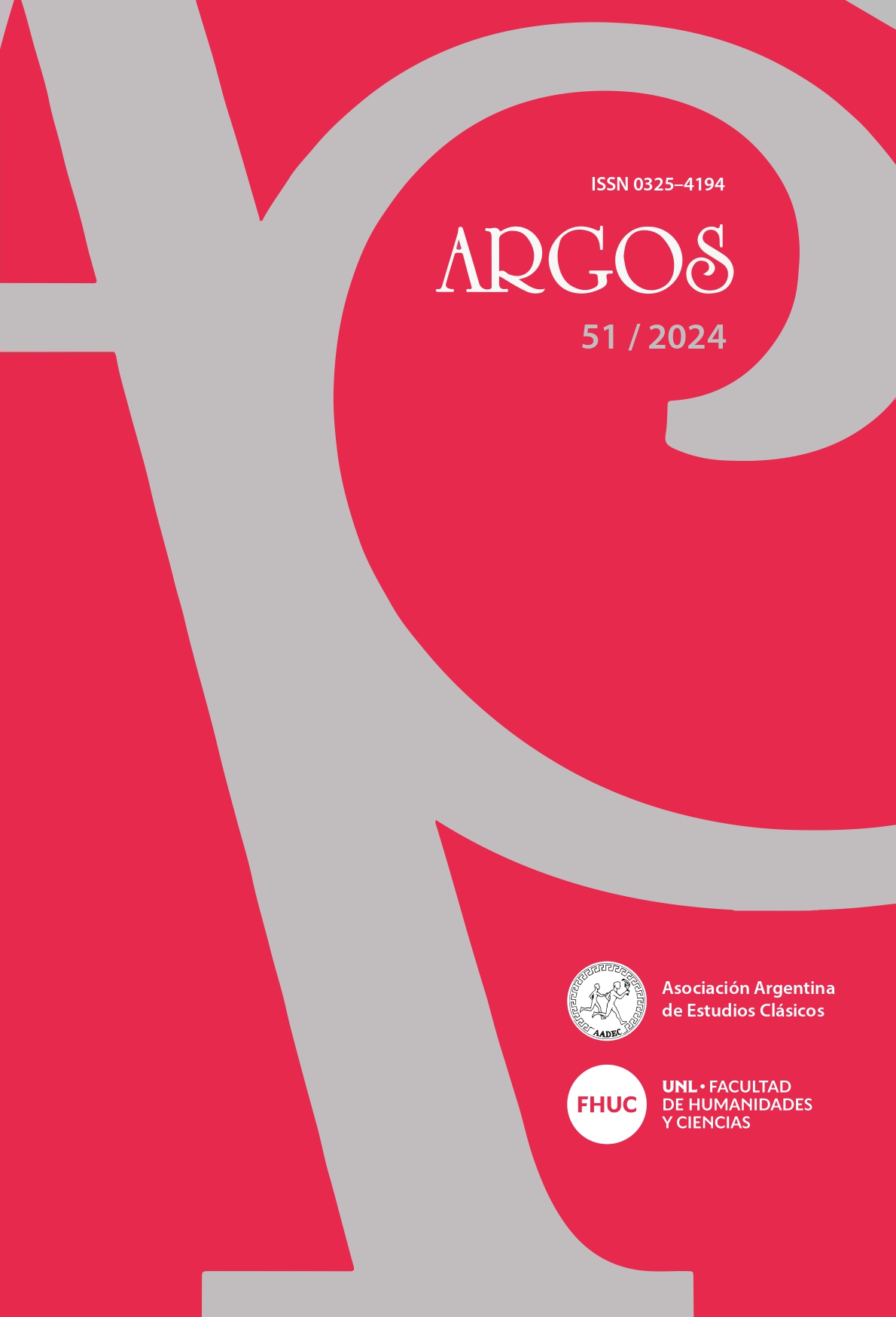What the peploi conceal. Female garments in Euripides’ Hecuba
DOI:
https://doi.org/10.14409/argos.2024.51.e0064Keywords:
peploi, Trojan women, female garments, Hecuba, EuripidesAbstract
The word πέπλος (“peplos”), which typically names the tunic worn by women, is
registered a total of eleven times in Euripides’ Hecuba. Taking into account the
bipartite structure of this tragedy and the significance of clothing in the Ancient
Greek world, this article intends to analyze the occurrences of this term in its
contexts, with the hypothesis that the peploi conceal but at the same time reveal
the nature of the female characters: Polyxena, the chorus of captive Trojan women
and Hecuba, as well as they allow the transformation of the last two in each part of
the play.
References
BARLOW, S. A. (1986) The Imagery of Euripides. A Study in the Dramatic Use of Pictorial
Language, Bristol Classical Press.
BONFANTE, L. (2004 [1997]) “Nursing Mothers in Classical Art”, en Koloski-Ostrow, A. O. y
Lyons, C. L. (Eds.) Naked Truths: women, sexuality and gender in classical art and
archeology, Routledge, pp. 174-196.
BRØNS, C. (2016) Gods and Garments. Textiles in Greek Sanctuaries in the 7th-1st
Centuries BC, Oxbow Books.
CAIRNS, D. L. (2002) “The Meaning of the Veil in Ancient Greek Culture”, en Llewellyn-
Jones, L. (Ed.) Women’s Dress in the Ancient Greek World, Classical Press of Wales,
pp. 73-94.
CAIRNS, D. L. (2009) “Weeping and Veiling: Grief, Display and Concealment in Ancient
Greek Culture”, en Fögen, T. (Ed.) Tears in the Graeco-Roman World, Walter de
Gruyter, pp. 37-57.
CHANTRAINE, P. (1968) Dictionnaire étymologique de la langue grecque, Klincksieck.
COHEN, B. (2004 [1997]) “Divesting the Female Breast of Clothes in Classical Sculpture”,
en Koloski-Ostrow, A. O. y Lyons, C. L. (Eds.) Naked Truths: women, sexuality and
gender in classical art and archeology, Routledge, pp. 66-92.
DUÉ, C. (2006) “The Captive Woman’s Lament and Her Revenge in Euripides’ Hecuba”, en
The Captive Woman’s Lament in Greek Tragedy, University of Texas Press, pp. 117-
HǺLAND, E. J. (2004) “Athena’s peplos: Weaving as a Core Female activity in ancient and
modern Greece”, Cosmos, 20, pp. 155-182.
IRIGOIN, J. (2002) “La composition architecturale de l’Hécube d’Euripide”, Cuadernos de
Filología Clásica: Estudios griegos e indoeuropeos, 12, pp. 163-172.
JENKINS, I. D. (1985) “The Ambiguity of Greek Textiles”, Arethusa, 18, pp. 109-132.
LEE, M. M. (2015) Body, Dress and Identity in Ancient Greece, Cambridge University
Press.
LIDDELL, H. G. y SCOTT, R. (1940 [1843]) A Greek-English Lexicon, revised and
augmented throughout by Sir Henry Stuart Jones with the assistance of Roderick
McKenzie, Clarendon Press.
LORAUX, N. (1989 [1985]) Maneras trágicas de matar a una mujer, Ramón Buenaventura
(Trad.), Visor.
LORAUX, N. (2004 [1990]) Madres en duelo, Ana Iriarte (Trad.), Abada Editores.
LOZANO GARCÍA, C. (2016) “La Hécuba de Eurípides: la perra que ladraba a la libertad”,
Tycho, 4, pp. 91-108.
MANSFIELD, J. M. (1985) The Robe of Athena and the Panathenaic Peplos, University of
California.
MARIÑO-CALVO, M. V. (2019) “Vestido-desnudo, femenino-masculino: formas de
representación del cuerpo y del sexo en el pensamiento griego antiguo”, Historias del
Orbis Terrarium, 22, pp. 25-46.
MARSHALL, C. W. (2001) “The Costume of Hecuba’s Attendants”, Acta Classica, 44, pp.
-136.
MOSSÉ, C. (2001 [1990]) La mujer en la Grecia Clásica, Celia María Sánchez (Trad.),
Nerea.
MOST, G. W. (2012) “Bifocal Reception: Hecuba vs. The Trojan Women”, Philia & Filia,
(2), pp. 28-36.
MUELLER, M. (2016) Objects as Actors. Props and the Poetics of Performance in Greek
Tragedy, The University of Chicago Press.
MUÑOZ LLAMOSAS, V. (2001) “La transgresión de ΑΙΔΩΣ en situaciones de máxima
tensión: Ifigenia, Casandra, Climetestra, Polixena y Helena”, Habis, 32, pp. 67-79.
NAVARRO NOGUERA, A. (2022) “El coro de troyanas en Hécuba: en busca del sentido de la
Guerra”, Cuadernos de filología clásica: Estudios griegos e indoeuropeos, 32, pp.
-113.
OLLER GUZMÁN, M. (2007) “Matar al huésped en la Hécuba de Eurípides”, Faventia, 29(1),
pp. 59-75.
POMEROY, S. B. (1990 [1987]) Diosas, rameras, esposas y esclavas. Mujeres en la
Antigüedad Clásica, Ricardo Lezcano Escudero (Trad.), Akal.
RODRÍGUEZ CIDRE, E. (2010) Cautivas troyanas. El mundo femenino fragmentado en las
tragedias de Eurípides, Del Copista.
RODRÍGUEZ CIDRE, E. (2019) “Ornamentación, esclavitud y violencia en Hécuba y Troyanas
de Eurípides”, Actes du Groupe de Recherches sur l’Esclavage depuis l’Antiquité,
(1), pp. 489-500.
RODRÍGUEZ CIDRE, E. (2021) “Mujer, corporalidad y monstruosidad en la tragedia
euripidea”, en Pricco, A. y Maiorana, D. (Comps.) y Moro, S. M. y Martí, M. E. (Eds.)
Mujeres en la literatura grecolatina: imágenes y discursos. Homenaje al Dr. Andrés
Pociña, Centro de Estudios Latinos “Prof. Beatriz Rabaza”, pp. 278-300.
ROMERO GONZÁLEZ, D. (2008) “El prototipo de mujer espartana en Plutarco”, en Nikolaidis,
A. G. (Ed.) The Unity of Plutarch’s Work. ‘Moralia’ Themes in the ‘Lives’, Features of
the ‘Lives’ in the ‘Moralia’, Walter de Gruyter, pp. 679-687.
ROSIVACH, V. J. (1975) “The First Stasimon of the Hecuba 444ff”, The American Journal
of Philology, 96(4), pp. 349-362.
SAUVAGEOT, C. y MENARD, R. (2007) Vestidos y peinados en las civilizaciones antiguas,
Jorge Iriarte Bustamente (Trad.), Quadrata.
SCHLEGEL, A. W. (1965 [1808]) “Lecture VIII”, en Course of Lectures on Dramatic Art and
Literature, John Black (Trad.), AMS Press, pp. 111-121.
SCODEL, R. (1996) “Δόμων ἄγαλμα: Virgin Sacrifice and Aesthetic Object”, Transactions
of the American Philological Association, 126, pp. 111-128.
SEGAL, C. (1990) “Golden Armor and Servile Robes: Heroism and Metamorphosis in
Hecuba of Euripides”, The American Journal of Philology, 111(3), pp. 304-317.
STAMATOPOULOU, Z. (2012) “Weaving Titans for Athena: Euripides and the Panathenaic
Peplos (Hec. 466-74 and IT 218-24)”, The Classical Quarterly 62(1), pp. 72-80.
TUCK, A. (2009) “Stories at the Loom: Patterned Textiles and the Recitation of Myth in
Euripides”, Arethusa, 42(2), pp. 151-159.
Downloads
Published
How to Cite
Issue
Section
License
Copyright (c) 2024 Argos

This work is licensed under a Creative Commons Attribution-NonCommercial-ShareAlike 4.0 International License.



